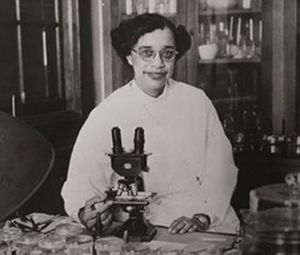Mary Logan Reddick facts for kids
Quick facts for kids
Mary Logan Reddick
|
|
|---|---|
 |
|
| Born |
Mary Logan
December 31, 1914 |
| Died | 1 October 1966 (aged 51) |
| Alma mater |
|
| Scientific career | |
| Fields |
|
| Institutions |
|
| Thesis | The differentiation of embryo chick medulla in chorioallantoic grafts (1944) |
Mary Logan Reddick (born December 31, 1914 – died October 1, 1966) was an important American scientist. She studied how brains develop, especially in embryos. This field is called neuroembryology.
Dr. Reddick earned her PhD from Radcliffe College, which was connected to Harvard University, in 1944. She became a full professor, first at Morehouse College, and then at the University of Atlanta. She worked there from 1953 until she passed away. Her research involved studying chick embryos and using special cameras to watch cells grow. This was called motion picture microphotography back then, but we now call it time-lapse microscopy.
In 1952, Dr. Reddick received a special Ford science fellowship. This allowed her to study at Cambridge University in England. She was likely the first African-American woman scientist to get this fellowship to study abroad. She was also the first female biology teacher at Morehouse College.
Early Life and Education
Mary Logan was born in Atlanta, Georgia, in 1914. She finished high school at the Laboratory High School. At just 15 years old, in 1929, she started studying biology at Spelman College.
Spelman is a college for women and is one of the historically black colleges. It was connected to the University of Atlanta and Morehouse College. These connections allowed her to learn from an African-American scientist named Samuel Milton Nabrit at Morehouse.
While studying for her bachelor's degree at Spelman, Mary Reddick also worked as a laboratory assistant. She continued this work for four years after graduating. She earned her bachelor's degree in 1935.
In 1937, she received a special grant called a Rockefeller Foundation General Education Board Fellowship. This helped her get a Master of Science degree from the University of Atlanta. For her master's thesis, she studied the early development of chick embryos.
Career and Advanced Studies
After getting her master's degree, Dr. Reddick began teaching biology at Spelman in 1937. In 1939, she made history by becoming the first female biology instructor at Morehouse College.
In 1942, she received another Rockefeller education fellowship. This time, it was from Radcliffe College, which was the women's college connected to Harvard University. For two years, Dr. Reddick studied how to transplant tissues and how nerve cells develop in chick embryos. She earned a second master's degree in biology in 1943 and her PhD in 1944. Her PhD paper was about how the brain's medulla develops in chick embryos. She was also chosen to join two important honor societies, Phi Beta Kappa and Sigma Xi.
Dr. Reddick returned to Morehouse College. She became the first woman to lead the biology department there. Later, she was promoted to a full professor.
In 1952, she received the Ford Foundation science fellowship. This allowed her to study embryology at Cambridge University in England. She was likely the first African-American woman to receive such a fellowship to study abroad.
She came back to the U.S. in 1953 and joined the faculty at the University of Atlanta. She became a full professor and was named the head of the biology department. During the 1950s and 1960s, she guided the research of more than 20 students. She also received a research grant from the National Science Foundation. She remained a professor there until she passed away in 1966 at the age of 51.
Embryological Research
Dr. Reddick's research focused on embryo development, especially in chickens. She used different types of chickens, like White Leghorns and Rhode Island Reds. She wanted to understand what different parts of a very early chick embryo could become. She did "cut-and-paste" experiments. This meant she would take a small piece from an early embryo and move it to a different part of a later-stage chick embryo.
Her experiments showed that a specific part of the early embryo, called the "node," was very important. It helped decide what many parts of the embryo would become, like skin, muscles, and organs. However, she also found that some parts needed to be near other tissues to develop correctly. For example, she only saw liver tissue develop if heart tissue was nearby.
For her PhD research, Dr. Reddick studied how the medulla, a part of the brain, develops in chick embryos. She used Plymouth Rock chickens for these studies. She wanted to know how much of this brain area was already set to become a certain thing. She also wanted to know how much it depended on interacting with surrounding tissues, like the notochord (a rod-like structure) and somites (blocks of tissue). Her results showed that while some parts of the medulla were already determined, they still needed to interact with surrounding tissues to develop fully.
Later, Dr. Reddick worked on improving ways to study cell development. She used White Plymouth Rock chicken embryos for these experiments. One question she explored was whether nerve cells in the chick medulla became connected in a large network during development. To see individual nerve cells clearly under the microscope, she used a special "smear" technique. This involved flattening the tissue before preparing it for viewing. She also discovered that what scientists thought were two different types of cells were actually the same cell type in different stages of their cell cycle. Some cells were dividing, and others were in a resting phase.

